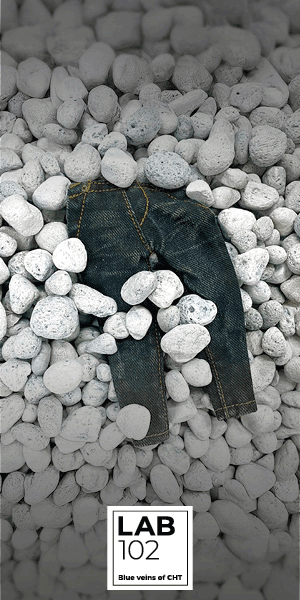A new spin on hemp

Innovation in hemp processing is helping the natural fibre shed its characteristic coarseness, without losing its rugged appeal. Technologies that produce finer and more homogenous fibres may enable the low impact, regenerative and biodiversity-friendly plant reach new heights in denim collections.
A new generation of hemp processors believes it can unlock the slow adoption of the original ‘slow’ fibre. Working closely with farmers and spinning mills, these entrepreneurs are also seeking to bridge the gaps in an industrial supply chain that has been decimated by globalisation and legislation.
A few years ago, Marmara Hemp had sparked renewed interest in hemp for jeans. Its initiator, Denis Druon, had rounded up a consortium of agricultural and industrial partners in France to develop a fibre offering and a brand name.
At the time, a few other hemp enthusiasts were also seeking to produce a fibre better suited to today’s optimised supply chains. UK-based SEFF has dedicated the past 15 years to this quest. “We’ve been called the best kept secret in hemp,” Josh Nusenbaum, SEFF founder and CEO, tells Inside Denim. “There has been a 70-year hiatus in hemp farming and processing in the USA, a lot of knowledge has been lost,” he says. When interest in the fibre returned a few years ago, he says, “many ran before they could walk”, which is why adoption by mills and brands did not take off.
SEFF is now ready to play a more visible role in the hemp revival. The company has recently hired a team of high-profile executives. Junaid Safdar, the new head of operations, previously worked at Bangladesh textile conglomerate Beximco, and denim expert Neil Bell has taken on the role of head of innovation. “The design community is passionate about hemp, but many hurdles hindered its uptake,” says Mr Bell. “SEFF has a technical solution that can unlock demand, and increase the proportion of hemp in fabrics, providing the characteristics that designers are looking for.” Incorporating only 10 to 15% hemp in a fabric is not compelling enough for him. Plus, he adds that any inconsistency across the supply chain “immediately kills the story”.
Making hemp mill-friendly
Like other companies in this field, SEFF sees removing the issue of fibre inconsistency as the solution to boosting the use of hemp grown in Europe and the United States. In other regions, notably China, harsh chemicals are commonly applied, and these are either forbidden, in the West, or negate the fibre’s environmentally-friendly nature.
SEFF’s hemp fibres undergo a special cottonisation method that yields consistent and uniform fibres of roughly the same length and thickness. They are degummed, a process that dissolves the ‘glues’ binding the fibres together, using a patented technology developed by the company. The Nano-Pulse machine sends high-voltage electric discharges in water to separate the fibres from the bundles. “It takes mere milliseconds and, more importantly, neither damages nor shortens the fibres,” says Mr Nusenbaum.
Tests conducted by DITF, a German textile research and engineering lab, found that SEFF’s hemp fibres presented low standard deviations in length, strength and fineness. “They are identical to cotton, and this removes any hurdles for all types of spinning machines, air jet, open end or ring,” he says. SEFF’s mill-friendly hemp makes it possible to incorporate higher proportions of the fibre into fabrics, up to 55% or even 70%.
Following a soft launch in 2019, and a mentorship at Fashion for Good in 2024-25, SEFF is now focusing on establishing a network of partner mills to bring the fibre to market. Spinning tests are underway with manufacturers in eight countries, most recently in Pakistan. Some are testing 60-70% hemp content, as the company’s goal is to increase the percentage of the bast fibre.
Industrial scale
Panda Biotech has built a 500,000 square-feet, fully automated hemp processing facility in Texas. Founded in 2019, the company is also seeking to rebuild an entire supply chain, and its business model even begins with the seeds. “We are creating a complete farm-to-fashion ecosystem,” Mark D’Sa, head of business development, tells Inside Denim. “We buy the seeds and the harvest of farmers located within a 300-mile radius of our plant in Wichita Falls.” The company’s innovative technology promises to provide the consistency and scale that the industry needs.
Panda Biotech hemp is enzymatically retted in the field. At the factory, it is then decorticated, cleaned, refined and cottonised to produce fibre, along with hurd, the coarse parts that add hair to the fibre after it is separated, and dust. These processes, including degumming, are entirely mechanical. This is what Mr D’Sa presents as a game-changer. “Using our advanced equipment and proprietary process, we produce a cottonised hemp fibre that is mill-ready,” he says.
The scale of the automated facility, which can process 10,000 tonnes per hour, allows Panda Biotech to offer its fibre at prices comparable to French grown hemp, and lower than that of other bast fibres such as linen or ramie, he says. The company is working closely with denim brands to integrate its US-grown and processed hemp into their fabrics. Twin Dragon (TDMI) and Global Denim, in Mexico, have been producing fabrics in blends of 20-30% hemp, that can also go up to 45-50%, says Mr D’Sa. “Hemp is a good fit for denim. It is the low hanging fruit.”
Clean-tech degumming
Based in Winston-Salem, Renaissance Fiber is also looking to support US-grown and processed hemp. Its first industrial facility, in Mocksville, will produce ready-to-spin fibre starting in 2026, with an expected annual capacity of 2 million pounds (900 tonnes). “By building this advanced refining capacity here in North Carolina, we are creating new opportunities for American farmers and manufacturers to shift to eco-friendly textiles,” says Daniel Yohannes, CEO and co-founder of Renaissance Fiber.
The company has devised a ‘clean’ biomimetic degumming process that controls fibre length, fineness and surface quality. “It can unlock hemp’s potential as a true plug-and-play fibre in textiles,” says Mr Yohannes. The method emulates natural blackwater estuary conditions, returning water to the watershed as it is naturally found in river ecosystems. This makes it an “ecologically invisible” degumming technology, as the company calls it.
Research is ongoing at Renaissance Fiber to achieve its targeted fineness, length and uniformity of length. “We’ve reduced variation by 50% on fineness and length, yielding greater consistency in fibre quality,” he says. Once cottonised, the fibres are suitable for spinning on many types of staple yarn equipment, including open-end (rotor), ring and vortex. The company is currently working with Mount Vernon Mills (MVM) on hemp denim fabrics. It has supplied fibre to Patagonia and, with partner spinners and mills, made functional fabrics for the Department of Defence.
While American companies are busy building up a new supply chain from farm to factory, in France, industrial hemp farming never came to a full stop. However, there are many missing links in the European industrial infrastructure for textile manufacturing. For decades, French growers focused on other end markets, but apparel end-uses are making a comeback, thanks in part to the Alliance of Linen & Hemp, which is working to reintroduce hemp as a textile fibre.
La Chanvrière, a major hemp growing cooperative founded in 1973 and based in Saint-Lyé, southeast of Paris, first began its R&D on hemp for textile applications in 2015. In 2017, it launched its first cottonised hemp fibres under the brand name Canalia. It is also working on producing finer and more homogenous fibres. The company is trialling a new washing technique that reduces irregularities enabling the production of yarns with 50% hemp, says Laurie Coutelot, marketing and sales manager. She says that when degummed, it is possible to include up to 70-80% hemp. She does, however, have reservations on the possibility of degumming the bast fibre without using chemicals.
Although renewed interest in hemp a few years ago did not reach the expected heights, Ms Coutelot says La Chanvrière’s sales volumes have remained constant. “Textile applications remain niche, but those customers that believe in it, and use it, continue to use it and believe in it.” Her key denim customers include Orta and Sharabati.
It is anticipated that, when higher volumes of mill-friendly hemp become available, manufacturers will be more willing to add the alternative natural fibre to their yarn, fabric and garment offerings. For Neil Bell, “SEFF’s plug and play solution brings confidence to the manufacturing community”. Marc D’Sa of Panda Biotech says that “demand is there. What is missing is a strong supply chain.”
A fibre of many assets
These hemp enthusiasts are also keen to promote the fibre’s technical assets. “Hemp is stronger than linen, but shares its antimicrobial, anti-UV and absorbency characteristics, adding performance to cotton,” says Josh Nusenbaum, at SEFF. Neil Bell believes mills are interested in hemp for its properties and its durability, while young designers are attracted to the environmentally friendly attributes of the natural fibre. “People aren’t buying hemp for its authenticity or ruggedness; they’re interested in the fibre’s performance,” he says.
The plant is touted as a carbon sink and provides many other environmental benefits. Research by the European Commission into hemp farming found that one hectare of hemp sequesters 9 to 15 tonnes of CO2. This, it states, is similar to the amount sequestered by a young forest, whereas hemp takes only five months to grow. The good story gets better when it comes to biodiversity. The plant’s flowering cycle is said to coincide with a lack of pollen production from other crops, and hemp produces large quantities of pollen. Hemp fields provide shelter for birds, and its seeds are a food for animals, as the report notes. Finally, the crop requires few to no pesticides.
The farmers who supply Panda Biotech apply regenerative techniques. “This is not because they have to, but because hemp’s fast growth, deep roots and natural canopy make these practices even more effective,” points out Mr D’Sa. It is the beauty of hemp, chimes in Laurie Coutelot of La Chanvrière. “Our Canalia brand offers the most natural form of the fibre, true to its low-impact profile.”
Sources of industrial hemp may also expand in the future. Ukraine is looking to grow its production. The war, and the rerouting of grain from its usual customers to Eastern European countries has disrupted the market, and suppliers, leading Ukrainian farmers to switch to hemp and avoid conflict with its allies. On the other side of the planet, Australia’s parliament has just launched a research programme into industrial hemp farming, citing soil health and the circular economy as beneficial to its development.
As hemp prepares to make a comeback, from the farms to the factories, in new mill-friendly formats, it should have no trouble weaving its way back into our wardrobes. Neil Bell says it makes sense in denim, and Josh Nusenbaum adds that “hemp has a soft spot in many people’s hearts”.
SEFF believes its mill-friendly hemp unlocks the fibre’s potential to be used in higher proportions and delivers the fibre’s inherent strength, comfort and hand feel.
Photo: SEFF













